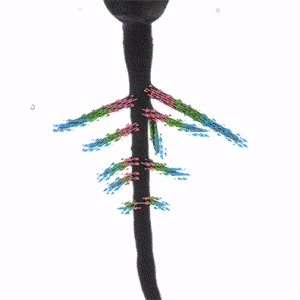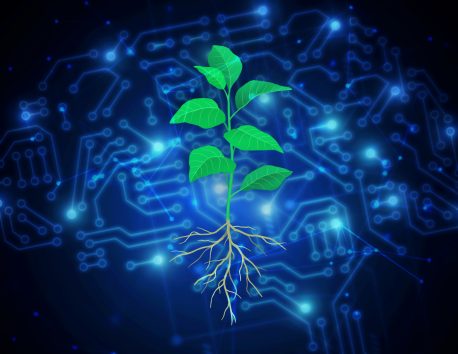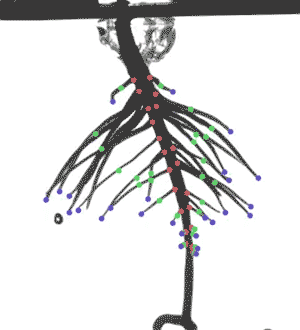Synthetic intelligence will assist specialists engineer crops to combat climate modify
A particular collaboration at Salk works by utilizing deep discovering utility referred to as SLEAP to research plant choices, accelerating construction of native climate-conserving vegetation
LA JOLLA—The Intergovernmental Panel on Native local weather Remodel (IPCC) declared that taking away carbon from the surroundings is now essential to stopping local weather change and limiting world broad temperature rise. To assist these endeavours, Salk researchers are harnessing crops’ natural capability to draw carbon dioxide out of the air by optimizing their root items to maintain extra carbon for an extended interval of time.
Click on proper right here for a significant-resolution impression.
Credit score historical past: Salk Institute
To design and magnificence these native weather-saving crops, specialists in Salk’s Harnessing Vegetation Initiative are making use of a refined new examine useful resource referred to as SLEAP—an quick-to-use synthetic intelligence (AI) program that tracks a number of capabilities of root development. Produced by Salk Fellow Talmo Pereira, SLEAP was to start with made to look at animal movement within the lab. Now, Pereira has teamed up with plant scientist and Salk colleague Professor Wolfgang Busch to make use of SLEAP to vegetation.
In a evaluate revealed in Plant Phenomics on April 12, 2024, Busch and Pereira debut a brand new protocol for working with SLEAP to research plant root phenotypes—how deep and large they develop, how massive their root methods develop to be, and different bodily traits that, previous to SLEAP, ended up tiresome to measure. The appliance of SLEAP to crops has presently enabled scientists to ascertain essentially the most complete catalog of plant root program phenotypes to day.
What is way extra, monitoring these precise bodily root method attributes assists scientists uncover genes affiliated with individuals options, as completely as regardless of whether or not a number of root qualities are recognized by the exact same genes or independently. This lets the Salk crew to determine what genes are most precious to their plant patterns.
“This collaboration is actually a testomony to what would make Salk science so specific and impactful,” claims Pereira. “We’re not simply ‘borrowing’ from numerous disciplines—we’re genuinely putting them on equal footing in purchase to provide one thing larger than the sum of its sections.”
Previous to using SLEAP, monitoring the precise bodily properties of each equally crops and animals important a considerable amount of labor that slowed the scientific methodology. If scientists most well-liked to evaluate a picture of a plant, they might might want to manually flag the areas of the graphic that had been being and weren’t plant—frame-by-body, part-by-section, pixel-by-pixel. Solely then may older AI variations be utilized to process the impression and collect knowledge concerning the plant’s construction.
Credit score rating: Salk Institute

Credit score: Salk Institute
What units SLEAP apart is its distinctive use of each equally laptop computer imaginative and prescient (the ability for pc methods to understand pictures) and deep discovering out (an AI method for education a private pc to review and carry out just like the human thoughts). This mix permits scientists to method visuals with out shifting pixel-by-pixel, alternatively skipping this intermediate labor-intense stage to leap straight from impression enter to described plant choices.
“We made a robust protocol validated in a number of plant sorts that cuts down on investigation time and human mistake, though emphasizing accessibility and simplicity-of-use—and it demanded no alterations to the precise SLEAP utility,” states to start out with creator Elizabeth Berrigan, a bioinformatics analyst in Busch’s lab.
With out the necessity of modifying the baseline technological know-how of SLEAP, the researchers made a downloadable toolkit for SLEAP termed sleap-roots (available as open-supply software program program on this article). With sleap-roots, SLEAP can system organic attributes of root items like depth, mass, and angle of development.
The Salk crew examined the sleap-roots bundle in a variety of crops, which embody crop vegetation like soybeans, rice, and canola, as properly because the product plant species Arabidopsis thaliana—a flowering weed within the mustard relations. Throughout the assortment of crops trialed, they recognized the novel SLEAP-based principally methodology outperformed present procedures by annotating 1.5 events quite a bit faster, instruction the AI product 10 moments quite a bit faster, and predicting plant framework on new details 10 occasions speedier, all with the precise or higher accuracy than proper earlier than.
Collectively with massive genome sequencing initiatives for elucidating the genotype data in enormous numbers of crop variations, these phenotypic details, a majority of these as a plant’s root process increasing particularly deep in soil, may be extrapolated to acknowledge the genes reliable for creating that specifically deep root method.
This step—connecting phenotype and genotype—is crucial in Salk’s mission to generate crops that preserve on to much more carbon and for longer, as people crops will need root units developed to be additional and much more sturdy. Implementing this correct and environment friendly software program program will let the Harnessing Crops Initiative to hook up fascinating phenotypes to targetable genes with groundbreaking ease and velocity.

Click on on this article for a high-resolution image.
Credit score rating: Salk Institute
“We have now by now been outfitted to take advantage of complete catalogue of plant root program phenotypes up to now, which is actually accelerating our exploration to make carbon-capturing vegetation that combat local weather enhance,” claims Busch, the Hess Chair in Plant Science at Salk. “SLEAP has been so easy to make the most of and use, many because of Talmo’s specialist software program type, and it’s prone to be an indispensable software program in my lab going ahead.”
Accessibility and reproducibility had been being on the forefront of Pereira’s thoughts when constructing each of these SLEAP and sleap-roots. Primarily as a result of the software program program and sleap-roots toolkit are completely free to make use of, the researchers are thrilled to see how sleap-roots shall be made use of all-around the planet. At the moment, they’ve begun conversations with NASA specialists hoping to make use of the machine not solely to help guidebook carbon-sequestering vegetation on Earth, but additionally to look at vegetation in place.
At Salk, the collaborative workers is just not nonetheless able to disband—they’re presently embarking on a brand new problem of inspecting 3D data with SLEAP. Initiatives to refine, increase, and share SLEAP and sleap-roots will proceed on for a few years to happen, however its use in Salk’s Harnessing Crops Initiative is now accelerating plant designs and helping the Institute make an affect on native local weather enhance.
Different authors contain Lin Wang, Hannah Carrillo, Kimberly Echegoyen, Mikayla Kappes, Jorge Torres, Angel Ai-Perreira, Erica McCoy, Emily Shane, Charles Copeland, Lauren Ragel, Charidimos Georgousakis, Sanghwa Lee, Daybreak Reynolds, Avery Talgo, Juan Gonzalez, Ling Zhang, Ashish Rajurkar, Michel Ruiz, Erin Daniels, Liezl Maree, and Shree Pariyar of Salk.
The carry out was supported by the Bezos Earth Fund, the Hess Company, the TED Audacious Challenge, and the Countrywide Institutes of Nicely being (RF1MH132653).
DOI: 10.34133/plantphenomics.0175
Read through far more on GOOLE Information


/cdn.vox-cdn.com/uploads/chorus_asset/file/25416307/1448234053.jpg)
